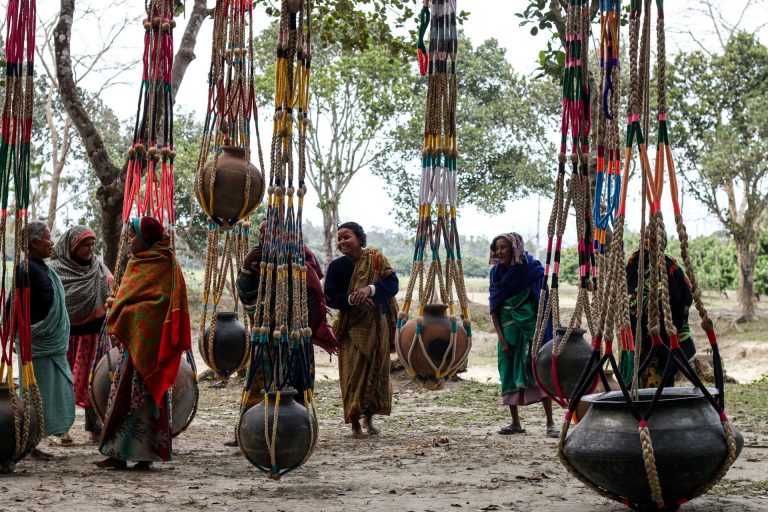We acknowledge the Traditional Owners of the land on which the Queensland Art Gallery | Gallery of Modern Art stands and recognise the creative contribution First Australians make to the art and culture of this country.

Kamruzzaman Shadhin / Bangladesh b.1974 / Gidree Bawlee Foundation of Arts / Bangladesh est. 2001 / The fibrous souls (works in development in Thakurgaon, Bangladesh) 2018–21 / Jute, cotton, thread, clay, brass / 70 pots: 40–100cm each (diam., approx.) with 70 shikas of various dimensions / Installed dimensions variable / Purchased 2021 with funds from Metamorphic Foundation through the QAGOMA Foundation / Collection: QAGOMA / © The artists
Kamruzzaman Shadhin and Gidree Bawlee Foundation of ArtsThe fibrous souls 2018–2021
Not Currently on Display
The fibrous souls explores part of Bangladesh’s colonial history through personal stories of movement and displacement. It is constructed with 70 giant shikas — embroidered, reticulated bags typically made of jute strings that are tied to a beam in the ceiling of houses and used to hold pots and food containers.
The stories that inspired The fibrous souls are drawn from families that had followed the railway tracks from what is now Bangladesh into India, after the British East India Company established the Eastern Bengal Railway. Operating under British Indian rule from 1892 to 1942, the railway served the profiteering trade interests of British India, fuelled by locally produced commodities such as jute, indigo and opium. The domination of these cash crops forced people to leave their lands and follow opportunities along the railway; however, during the 1947 Partition of India, they found themselves separated from their homes by a new national border, only to be forced back over from India into present-day Bangladesh.
Working with 13 women hailing from jute-making families to construct the shikas — each one unique — Kamruzzaman Shadhin and the Gidree Bawlee Foundation of Arts have constructed a giant hanging system, laid out as the map of the historic Eastern Bengal Railway. The hanging brass, jute and clay storage pots symbolise the stations of towns and cities on the railway map — from Calcutta (now Kolkata) and Chittagong (officially Chattogram) in the south, to Darjeeling and Guwahati in the north — signifying the defining role this piece of colonial infrastructure has played in shaping their lives.
Over more than 20 years, Kamruzzaman Shadhin has developed new possibilities for contemporary art in Bangladesh, centred around the communities of his home village of Balia in the far north-western state of Thakurgaon. In 2001, he established the Gidree Bawlee Foundation of Arts to work with local indigenous Santhal communities. The foundation seeks to be a catalyst for social inclusivity through collaborative approaches.
Kamruzzaman is also one of the Bangladesh’s foremost contemporary artists, known for his installations and performances that address environmental and social issues, particularly those facing regional Bangladesh and its communities. Together with Gidree Bawlee, he produces ambitious contemporary art projects that explore shared culture and histories, and promote community development.